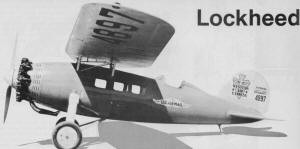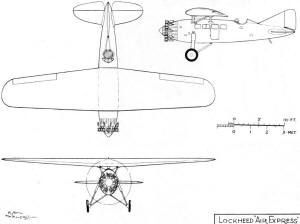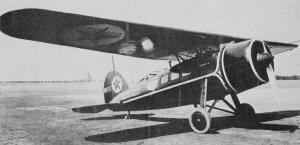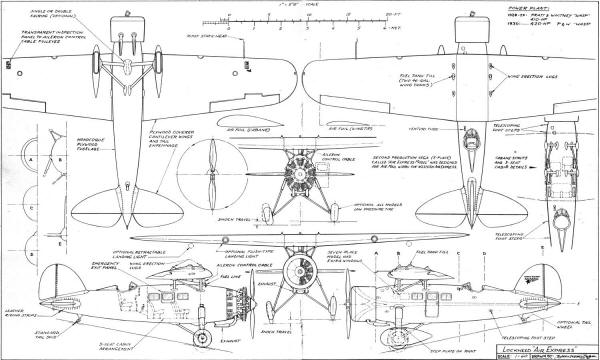|
Don Berliner was a prolific researcher
and publisher of books about model airplanes and full-size airplanes. His articles
and photographs, often graced by master draftsman and artist Bjöurn Karlström's
drawings, appeared fairly often in American Aircraft Modeler. Here, Don
gives a brief history of the Lockheed Air Express. One interesting note is that
the aircraft featured an open cockpit - even though the passenger compartment was
completely enclosed - at the insistence of pilots (many former Air Mail men) who
claimed they needed the multi-sensory environment for safe navigation because it
allowed them feel the wind shifts and changes in attitude. Website visitor Christopher W.
requested this article. Lockheed Air Express
When John Northrop designed this four-passenger, 176-mph craft, it was the ultimate
in comfort. Though only seven took to the sky, they became world famous.
By Don Berliner Photos from Smithsonian Institution
 Although it came after the Vega with
its enclosed cabin for the pilot, the Air Express reverted to an open cockpit.
 Three-view shows less successful forerunner
of production version. |
WILL ANYONE REMEMBER how it all started? In a few weeks, as this is
written, Lockheed Aircraft Co. will erupt with great gobs of excitement as its newest
airliner takes to the skies for the first time. The 250-300-passenger 1011 TriStar
will carry with it the hopes and future of a great company which, like so many today,
is in somewhat wobbly financial condition. Within a couple of years, scores of these
majestic big ships should be cruising the airways. But will anyone remember
the Air Express? Before the TriStar came a long line of Lockheed commercial
airplanes: the Electra II, the Constellation, the pre-war Electra, the Lodestar,
the Vega, and finally back to the Air Express, Lockheed's first passenger carrier.
Then, as now, the new airplane was much more than merely the latest combination
of technical ideas. It was a big step forward. The world of 1928,
when the first Air Express appeared, was a far different place from the one we know
today. Airline travel was something that appealed to only a few brave businessmen.
Flying demanded nerve and ingenuity and the ability to navigate with only the crudest
of instruments and almost no ground-based aids. A 300-passenger, 600-mph luxury
liner would have been worthless.
| Dimensions Length - 27' 6" Wingspan - 42' 6" Wing
Area - 288 sq. ft. Height - 8' 4½" Empty Weight - 2533 lb. Gross
Weight - 4375 lb. Performance Top Speed - 167 mph (without
cowl)
176 mph (with cowl) Cruising Speed - 135 mph Landing Speed - 55 mph
Rate of Climb - 1500 ft./min. Service Ceiling - 17,250 ft. |
But a four-passenger, 135-mph Air Express with a completely enclosed cabin for the
"ultimate" in comfort was a much more realistic project for the time. The machine
designed by John Northrop was in many ways a real advancement in the art, and in
other ways a step backward. While its basic layout was certainly sleek and streamlined,
it placed the pilot far aft of the passenger cabin and out in the open as in most
earlier designs. Shortly before the Air Express bowed in, the Lockheed
Vega had been introduced to the public. It featured a cockpit just ahead of the
cabin, with its windshield faired into the leading edge of the high wing. Airmail
pilots of that era were hesitant about being completely enclosed. Many of them were
convinced they could fly only if out in the breeze where their practiced ears could
sense the winds and changes in attitude. Lockheed went along with this idea and
produced the Air Express with an open cockpit and a strut-braced wing to permit
forward visibility. The forerunner of the Air Express was a special
built for Western Air Ex-press, Inc., in June, 1928. On the first trip for its owners,
it was badly damaged in a landing accident at Las Vegas, Nevada, and returned to
the factory. There, it was completely rebuilt into the prototype Air Express and
became one of the most famous long-distance record setters of its time. Frank Hawks,
the famed "Dawn-To-Dusk" pilot, set a West-East transcontinental record of 18 hours,
21 minutes in February, 1929. Then, in late June, he earned his place in the sun
by setting back-to-back transcontinental records, flying from New York to Los Angeles
in 19 hours, 10 minutes and, after a brief rest, back to New York in 17 hours, 38
minutes. Hawks and the Air Express were famous.
 Texaco's Air Express was a plush predecessor
to today's corporate aircraft. One of the most famous long-distance record setters
was flown by Frank Hawks to west-to-east and east-west transcontinental marks in
1929. By then, a full cowl and spinner added to its performance. |
The first production Air Express was sold to the New York, Rio and Buenos Aires
Air Line in March, 1929. It was to have been used for carrying the mail around Argentina
- possibly using floats - but the airline was soon bought out by Pan Am and the
airplane vanished without a trace.But the next ship off the line more
than made up for the lack of fame of its predecessor. NR/NC-3057 lived through several
of the most exciting years in the history of any airplane before it was broken up
in 1940. Carrying the Lockheed name "The Black Hornet" (other Air Express were built
with Pratt & Whitney Wasps; this one had a P&W Hornet), it failed to set
a transconti-nental record in 1929 and was sold to the General Tire & Rubber
Co. and renamed "The General Tire." Henry J. Brown flew it to first place in the
forerunner of the classic Bendix Trophy Race: the Los Angeles-to-Cleveland race
of the 1929 Cleveland National Air Races. Its time of 13 hours, 15 minutes was 36
minutes faster than the runner-up Lockheed Vega, and its average speed of 186 mph
for well over 2000 miles was a real testimony to its class. The next
change in ownership for "3057" saw the beginning of one of the greatest publicity
stunts in aviation history. A little known but enterprising airline pilot named
Roscoe Turner talked the owner of the Gilmore Oil Co. into buying the airplane,
renaming it "The Gilmore Lion" in honor of the firm's trademark, and letting him
fly it all over the country in the company of a young lion named (what else?) "Gilmore."
Turner, Gilmore, Gilmore products and the cream-and-red Air Express went everywhere
and were seen by just about everyone. Yet it wasn't just a series of stunts.
There was more to it than flying into one airport after another to dazzle people
with the jazzy airplane and to shock them with the playful pet. Colonel Turner was
as speed oriented as any pilot of his day, and records were waiting to be broken.
In May 1930, he sped from Long Island to Glendale, Calif., in 18 hours, 43 minutes
for a new record. It didn't hurt Turner's reputation or Gilmore's sales. The next three Air Express completed were Wasp-powered versions: one for Texas Air
Transport, one for the South American airline that was absorbed by Pan Am, and one
used for sport by a succession of wealthy New Yorkers. The seventh and last Air
Express (not counting two that were never completed but were sold for replacement
parts to owners of originals) was ordered in 1930 but not completed until 1931.
It was intended for a transatlantic flight that never came off. This
last Air Express - NR/NC-974Y - got off to a very slow and discouraging start, but
picked up speed and became an historic airplane before it finally was wiped out
in a Nevada desert windstorm in 1942. Hoping to be the first woman to fly from New
York to Paris, young Laura Ingalls laid her tiny hands on the Air Express after
the sponsoring Atlantic Exhibition, Inc., gave up, and the two became fast friends.
Miss Ingalls had already made a name for herself in aviation by claiming, among
other things, a couple of typical Roaring Twenty's records: 980 consecutive loops
and 714 consecutive barrel rolls. During March and April, 1934, Laura
Ingalls became the first person to fly solo around South America, her 23-country
flight covering almost 17,000 miles and winning her the 1934 Harmon Trophy. This
was followed by a second place in the 1936 Bendix Trophy Race in a Lockheed Orion.
In 1936, the Air Express was sold to the Masakatsu brothers who hoped
to fly it non-stop to Japan but never did. Two more owners and half a war later,
the last of the Air Express line bit the dust. There isn't much left
now. None of the seven airplanes is known to exist, and the pilots who made headlines
in them are gone, too. The open-cockpit Lockheed was more glamorous but the Vega
became the commercial success.
 The prototype Air Express flown by Frank Hawks was a rebuilt special made for Western
Air Ex-press, Inc., in June of 1928. The first production model was sold to the
New York, Rio and Buenos Aire's Air Line-in 19'29. P&W power. Hornet ver-sion
averaged 186 mph in 2000-mile air race.
Notice:
The AMA Plans Service offers a
full-size version of many of the plans show here at a very reasonable cost. They
will scale the plans any size for you. It is always best to buy printed plans because
my scanner versions often have distortions that can cause parts to fit poorly. Purchasing
plans also help to support the operation of the
Academy of Model Aeronautics - the #1
advocate for model aviation throughout the world. If the AMA no longer has this
plan on file, I will be glad to send you my higher resolution version.
Try my Scale Calculator for
Model Airplane Plans.
Posted September 14, 2013
|



